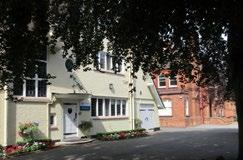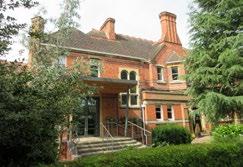
3 minute read
The Carillon Tower
Town Trail For 525 years Loughborough Grammar School has been a significant part of Loughborough. This 3km trail looks at its history and the influence of its pupils on the town. Sponsored by the Old Loughburians’ Association
The trail begins looking down the School’s Quadrangle from Burton Walks.
1 The 1852 Building
The School moved here, to its fourth home, in 1852. Designed by John Morris and built at a cost of £6,612 it consisted of two large halls, two classrooms in the Tower and Headmaster’s house with boarding accommodation. It opened with 71 boys but has since expanded to its current size of 925, 69 of whom are boarders. As you look from the Quadrangle gates, on the right hand side at the far end is the Library, originally Science Labs added in 1895, and at the near end is what was originally ‘Sloyd’, the manual training room, built in 1896. Both of these were designed by George Barrowcliff (LGS 1875- 81). He also designed the Reading Room and expansion of School House on the far left, added in 1904. The Queen’s Building with its stained glass window, was opened by Her Majesty the Queen in June 1996 to mark the School’s Quincentenary. The smaller Barrow Building, opened in 1925 and named after a Chair of Governors, is sandwiched between Queen’s and Cope, the nearest building to you which opened in 2000. In the 1930s the School expanded to the other side of Burton Walks with
a Gym and Swimming Pool. In 1961 the Hodson Hall was built with the help of a bequest from F W Hodson (LGS 1881-88) and more recently the Sports Hall (1981); Burton Hall (1991); Maths and Science Park (2013) and Astro Turf (2019) have all been added. On certain days the original building will be open. There you can go up the Tower; see the original school room and also an exhibition of the life of Air Vice Marshal Johnnie Johnson (LGS 1924-32) top pilot of WW2. Contact the School for details.
Turn round and proceed to the right down Burton Walks.
The seven houses of Burton Walks were built between 1880 and 1929 and were private houses until the School bought them at various times from 1948, purchasing the last one in 1998. Their residents represented some of the ‘great and good’ of Loughborough. The ‘white’ house, Buckland, (No 6) had two of the most famous of these who were at school together from 1875 to 1879. Architect George Barrowcliff built it in the style of Charles Vosey in 1903 and lived there until 1913 when he sold it to E Denison Taylor, Chairman of Taylor’s Bell Foundry, who lived there until his death in 1947. The next house, Red House (No 5), is well known because of a failed fire bomb outrage by the Suffragette movement on the night of 18 October 1913, one of only two buildings in Leicestershire to suffer such a fate. Amongst the residents of the remaining houses were Frederick Burder,

Director of Messengers (No 4); Henry Deane, solicitor (No 3); Joseph Hands, solicitor, and Thomas Cartwright, head of Cartwright & Warners (No 2); Richard Clifford, Mayor; Thomas Marshall-Green, Gent’s Outfitter and Henry Purnell, Chairman Herbert Morris (No 1). More details can be found in ‘publications’ at www.lgs-heritage.org
Continue towards the barrier in front of you, on your left is Loughborough High School.
3 Loughborough High School

What was then ‘The Girls Grammar School’ moved here in 1879 from Chesterton House. It changed name in 1893 and now educates 600 girls.
Continue through the ‘kissing gate’ and head straight down Victoria Street, across Bedford Square and down New Street to the Carillon Tower.



